The value1961.91 value was a typo. I already wrote that.
If you don’t want to test my values, then i can’t help you. I don’t have the opportunity for a test with your values. The 45.4mm diameter is not important. You have to consider the gear ratio.
That is not “only simple math”. That is also mechanics as described in the video.
You mention about the gear ratio which from my understanding is the difference between the drive pulleys from the motor pulley to the shaft pulley. I have previously stated that that is a 1:1 ratio in my setup. The motor pulley is a 20 tooth pulley and the pulleys on the shafts ate also 20 tooth pulleys. Because of that, the belt system is acting a if the motor was directly connected to the 2 shafts as far as rotational drive. That was why i said that the 45.4 diameter does matter and that is why i asked you to show how you came up with your number.
I think part of the confusion here is that Lightburn asks for an object diameter which, with a roller system, is mostly irrelevant. The object edge rotational speed will be the same as that of the roller that it’s touching. The object diameter is only needed with a chuck style system.
Note: I say ‘mostly’ irrelevant as you might still need to compensate for object diameter if you are engraving a tapered or necked object where the target area is of a different diameter than the portion touching the rollers.
Mike, thanks for your reply. I am not confused about the object diameter at all. If you read the responses from Wilfried, he is coming up with a number that I think should just be the diameter of the roller wheels that I am using, but the number he has is significantly higher than my calculation of 142.628 at 196.191. This is one of his quotes “You have a transmission from the pulleys to the roller shaft. 45.4 : 12.73mm = 3,56 as shown in the video.” What I was explaining to him is that the motor pulleys and the roller shaft pulleys are the same, so why would the transmission from the pulleys to the roller shaft have any bearing on this at all? If the motor shaft pulley was a different size than the roller shaft pulley, then Yes, you would need to account for the ratio between the two pulley sizes, but with the pulleys being the same size, it is a 1 to 1 ratio which is no different than if the motor was directly coupled to the roller shaft, correct? Or am I missing something here?
Unless someone needs me to respond to another post, this will be my last post on this and is being posted for reference so anyone searching on this has the correct information. So I ended up having to change my controller. I went with a CamTool 3.5 GRBL controller. I now have it set up with my rotary and it appears to be working pefectly. And for the record, I was correct on the values that I used. 142.628 was the circumference of the roller wheels calculated from the 45.4mm diameter of the roler wheels. I did not have to do the calculations that Wilfried was mentioning because having the same pulleys on the motor shaft and the roller shafts meant that the ratio between those pulleys was a 1:1 ratio. A 1:1 ratio means that in essence the roller wheels are acting as if they were directly connected to the motor shaft with no increase or reduction between them. All axis on this controller are permanently set to 1/16 microstepping with no way to change them without a modification to the board. The calculated steps per mm for the roller wheels is 22.4352 which is 1.4022 (the steps per mm at the default 200 steps per revolution of the motor) multiplied by 16 (microstepping).
Wilfried, The calculations that you were referring to in the video were calculations used if you were connecting the rotary tool to the existing Y axis and were using the current steps per mm from the Y axis in your calculations. The fact that I was using the Z axis meant that I needed to do my calculations as if the roller wheels were directly connected to the motor shaft with no need to figure in an existing value. The calculations shown in that video were more confusing than they needed to be. I think a big part of that was the video jumping back and forth between the German explanation and the English translations.
Thanks for all the help from everyone in this thread, even you Wilfried.
You are right, I was on a wrong way.
This topic was automatically closed 30 days after the last reply. New replies are no longer allowed.
